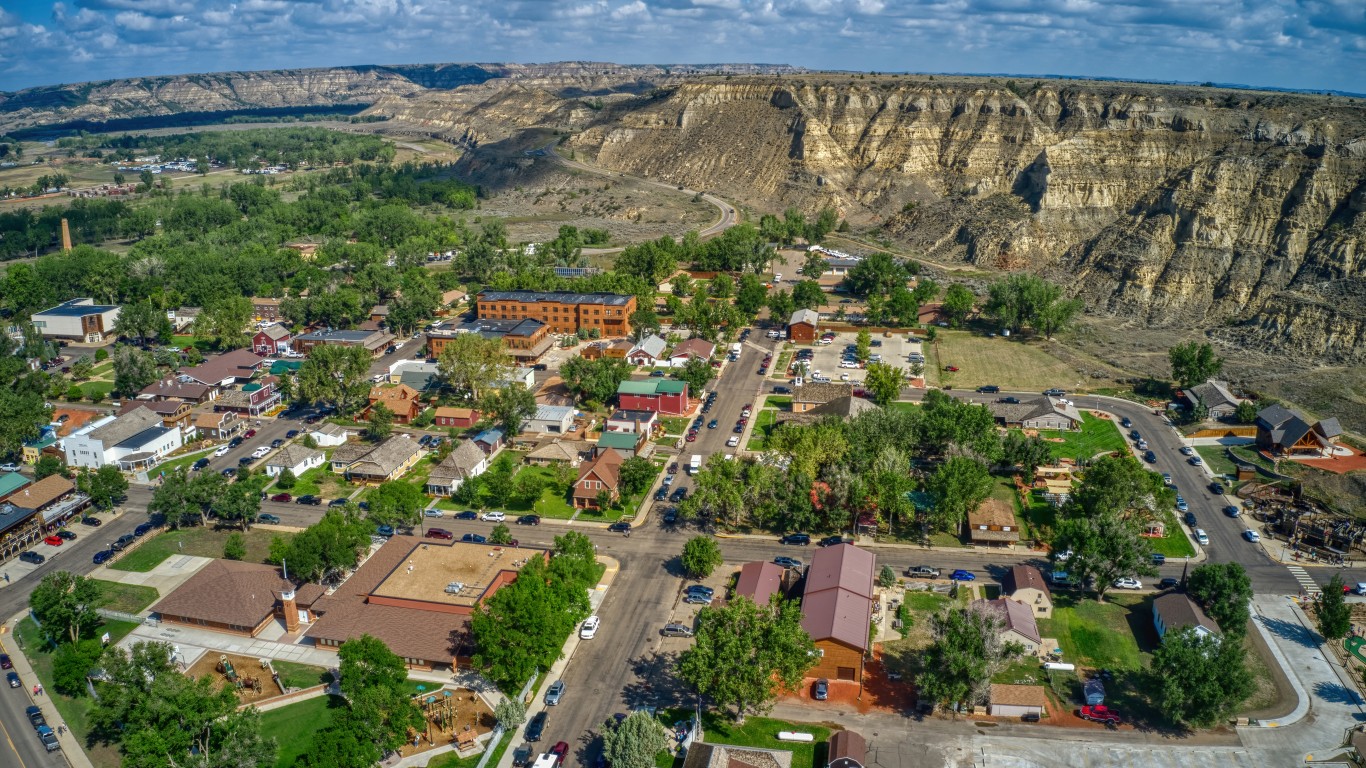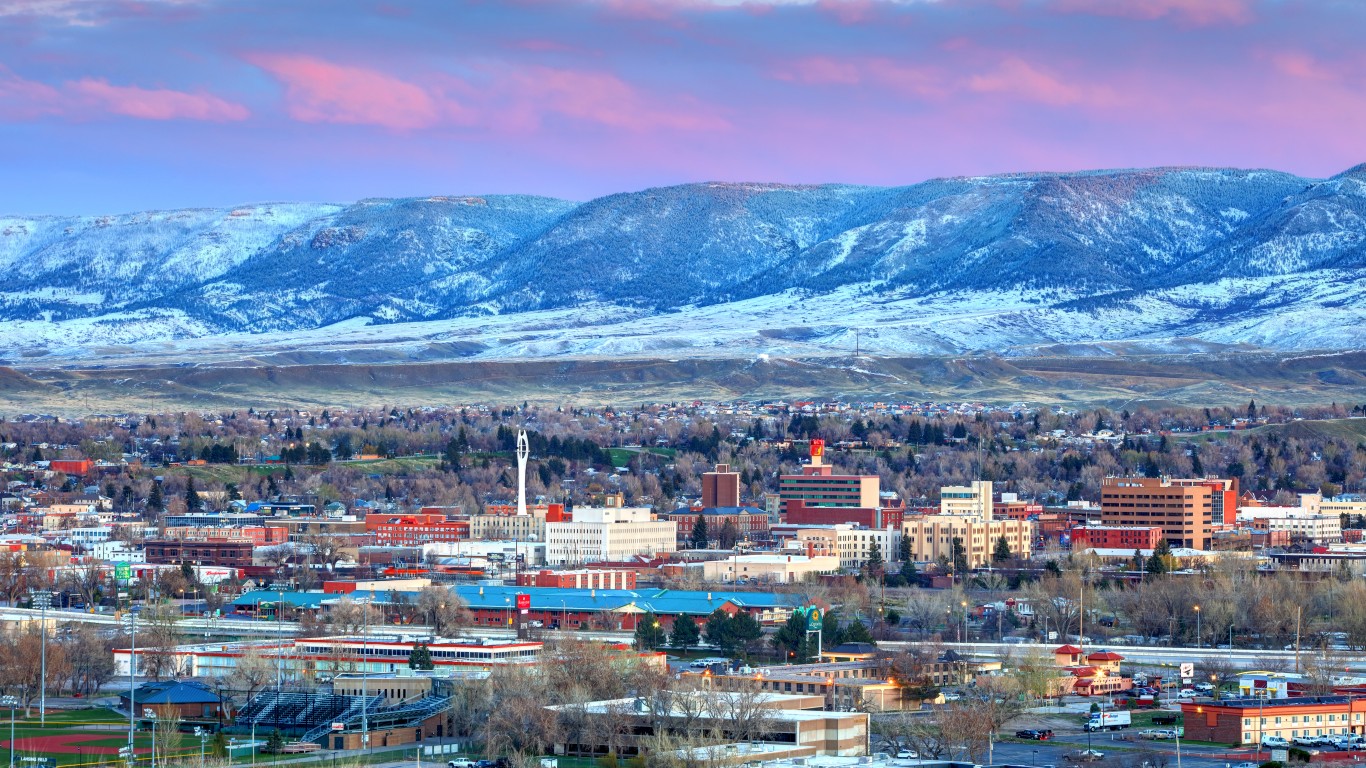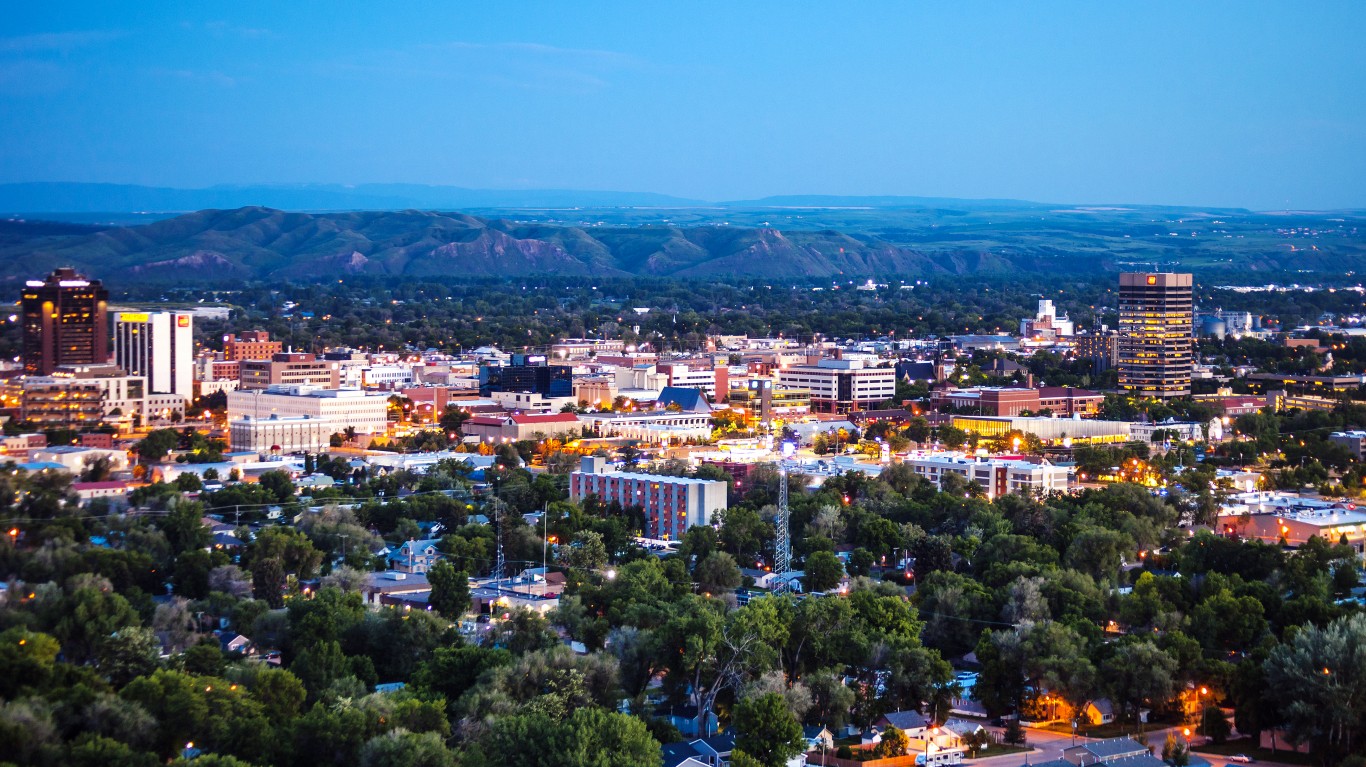Special Report
States Where the Most People Quit Their Jobs Last Month

Published:
Last Updated:

Americans have been quitting their jobs in record numbers in recent months – a trend that shows few signs of slowing. According to a recent report from the Bureau of Labor Statistics, nearly 4.2 million Americans quit their job in July 2022, only slightly below the all-time high of 4.5 million reported in November 2021.
A recent survey published by the Pew Research Center found that low pay and limited room for advancement were the most common reasons workers have been leaving their jobs. (Here are the states recovering the fastest from high unemployment.)
But whatever the explanation, the consequences are clear. Record-high quits are exacerbating the labor shortage in the United States and creating an existential crisis for many small businesses. And in some states, quit rates are far higher than the national average.
Using data from the BLS, 24/7 Wall St. identified the states where the most people are quitting their job. States are ranked by the number of people who quit in July 2022 as a share of total employment.
Nationwide, 2.7% of workers nationwide quit their jobs in July. In 30 states, the quit rate exceeded the national average. In these states, anywhere from 2.8% to 4.5% of workers quit their job in July.
Though there are some exceptions, most states with higher than average quit rates tend to have lower unemployment rates – below the national average of 3.5%. Since quits do not include workers who retire, each of the 4.2 million workers who quit in July presumably plans to take another job. A stronger job market, therefore, may incentivize workers to look for better opportunities, while a weaker job market may deter quits. (Here is a look at the states where unemployment is at an all time low.)
Click here to see states where the most people quit their jobs last month.
Click here to see our detailed methodology.

30. North Dakota
> Quits in July 2022: 2.8% of workforce (12,000 total quits)
> July 2022 unemployment: 2.3% (9,587 people)
> 1-year change in number of workers who quit: No change
> Labor force size: 409,789 people
[in-text-ad]

29. Rhode Island
> Quits in July 2022: 2.8% of workforce (14,000 total quits)
> July 2022 unemployment: 2.7% (15,339 people)
> 1-year change in number of workers who quit: 16.7% (2,000 more quits)
> Labor force size: 573,306 people

28. Maine
> Quits in July 2022: 2.8% of workforce (18,000 total quits)
> July 2022 unemployment: 2.8% (19,317 people)
> 1-year change in number of workers who quit: -5.3% (1,000 fewer quits)
> Labor force size: 678,646 people

27. New Mexico
> Quits in July 2022: 2.8% of workforce (24,000 total quits)
> July 2022 unemployment: 4.5% (42,294 people)
> 1-year change in number of workers who quit: No change
> Labor force size: 948,930 people
[in-text-ad-2]

26. Nevada
> Quits in July 2022: 2.9% of workforce (42,000 total quits)
> July 2022 unemployment: 4.4% (67,146 people)
> 1-year change in number of workers who quit: 10.5% (4,000 more quits)
> Labor force size: 1,521,130 people

25. Indiana
> Quits in July 2022: 2.9% of workforce (94,000 total quits)
> July 2022 unemployment: 2.6% (88,014 people)
> 1-year change in number of workers who quit: 3.3% (3,000 more quits)
> Labor force size: 3,393,932 people
[in-text-ad]

24. Arkansas
> Quits in July 2022: 3.0% of workforce (40,000 total quits)
> July 2022 unemployment: 3.3% (44,613 people)
> 1-year change in number of workers who quit: 5.3% (2,000 more quits)
> Labor force size: 1,356,042 people

23. Virginia
> Quits in July 2022: 3.0% of workforce (122,000 total quits)
> July 2022 unemployment: 2.7% (116,059 people)
> 1-year change in number of workers who quit: 19.6% (20,000 more quits)
> Labor force size: 4,354,000 people

22. Texas
> Quits in July 2022: 3.0% of workforce (404,000 total quits)
> July 2022 unemployment: 4.0% (589,205 people)
> 1-year change in number of workers who quit: 1.5% (6,000 more quits)
> Labor force size: 14,584,437 people
[in-text-ad-2]

21. New Hampshire
> Quits in July 2022: 3.1% of workforce (21,000 total quits)
> July 2022 unemployment: 2.0% (15,002 people)
> 1-year change in number of workers who quit: 5.0% (1,000 more quits)
> Labor force size: 766,697 people

20. Colorado
> Quits in July 2022: 3.1% of workforce (88,000 total quits)
> July 2022 unemployment: 3.3% (107,471 people)
> 1-year change in number of workers who quit: -9.3% (9,000 fewer quits)
> Labor force size: 3,250,281 people
[in-text-ad]

19. Florida
> Quits in July 2022: 3.1% of workforce (293,000 total quits)
> July 2022 unemployment: 2.7% (283,170 people)
> 1-year change in number of workers who quit: 4.6% (13,000 more quits)
> Labor force size: 10,657,055 people

18. Delaware
> Quits in July 2022: 3.2% of workforce (15,000 total quits)
> July 2022 unemployment: 4.4% (22,212 people)
> 1-year change in number of workers who quit: 7.1% (1,000 more quits)
> Labor force size: 500,469 people

17. Idaho
> Quits in July 2022: 3.2% of workforce (26,000 total quits)
> July 2022 unemployment: 2.6% (24,427 people)
> 1-year change in number of workers who quit: -7.1% (2,000 fewer quits)
> Labor force size: 952,401 people
[in-text-ad-2]

16. Alabama
> Quits in July 2022: 3.3% of workforce (69,000 total quits)
> July 2022 unemployment: 2.6% (59,359 people)
> 1-year change in number of workers who quit: 4.5% (3,000 more quits)
> Labor force size: 2,291,833 people

15. Missouri
> Quits in July 2022: 3.3% of workforce (97,000 total quits)
> July 2022 unemployment: 2.5% (77,923 people)
> 1-year change in number of workers who quit: 15.5% (13,000 more quits)
> Labor force size: 3,055,883 people
[in-text-ad]

14. North Carolina
> Quits in July 2022: 3.3% of workforce (157,000 total quits)
> July 2022 unemployment: 3.4% (171,657 people)
> 1-year change in number of workers who quit: -13.3% (24,000 fewer quits)
> Labor force size: 5,115,079 people

13. Oklahoma
> Quits in July 2022: 3.4% of workforce (57,000 total quits)
> July 2022 unemployment: 2.9% (54,916 people)
> 1-year change in number of workers who quit: -5.0% (3,000 fewer quits)
> Labor force size: 1,879,867 people

12. Arizona
> Quits in July 2022: 3.4% of workforce (105,000 total quits)
> July 2022 unemployment: 3.3% (118,742 people)
> 1-year change in number of workers who quit: 25.0% (21,000 more quits)
> Labor force size: 3,584,437 people
[in-text-ad-2]

11. Wyoming
> Quits in July 2022: 3.5% of workforce (10,000 total quits)
> July 2022 unemployment: 3.0% (8,780 people)
> 1-year change in number of workers who quit: -9.1% (1,000 fewer quits)
> Labor force size: 290,095 people

10. West Virginia
> Quits in July 2022: 3.5% of workforce (25,000 total quits)
> July 2022 unemployment: 3.7% (29,581 people)
> 1-year change in number of workers who quit: 8.7% (2,000 more quits)
> Labor force size: 797,404 people
[in-text-ad]

9. Vermont
> Quits in July 2022: 3.6% of workforce (11,000 total quits)
> July 2022 unemployment: 2.1% (6,989 people)
> 1-year change in number of workers who quit: -8.3% (1,000 fewer quits)
> Labor force size: 335,605 people

8. Montana
> Quits in July 2022: 3.6% of workforce (18,000 total quits)
> July 2022 unemployment: 2.7% (15,118 people)
> 1-year change in number of workers who quit: 5.9% (1,000 more quits)
> Labor force size: 565,913 people

7. Mississippi
> Quits in July 2022: 3.6% of workforce (42,000 total quits)
> July 2022 unemployment: 3.6% (46,108 people)
> 1-year change in number of workers who quit: 10.5% (4,000 more quits)
> Labor force size: 1,268,193 people
[in-text-ad-2]

6. Louisiana
> Quits in July 2022: 3.6% of workforce (70,000 total quits)
> July 2022 unemployment: 3.7% (76,876 people)
> 1-year change in number of workers who quit: 12.9% (8,000 more quits)
> Labor force size: 2,104,515 people

5. South Carolina
> Quits in July 2022: 3.6% of workforce (80,000 total quits)
> July 2022 unemployment: 3.2% (75,661 people)
> 1-year change in number of workers who quit: 14.3% (10,000 more quits)
> Labor force size: 2,399,624 people
[in-text-ad]

4. Tennessee
> Quits in July 2022: 3.6% of workforce (115,000 total quits)
> July 2022 unemployment: 3.3% (114,086 people)
> 1-year change in number of workers who quit: 18.6% (18,000 more quits)
> Labor force size: 3,409,644 people

3. Kentucky
> Quits in July 2022: 3.7% of workforce (72,000 total quits)
> July 2022 unemployment: 3.7% (77,135 people)
> 1-year change in number of workers who quit: 2.9% (2,000 more quits)
> Labor force size: 2,063,623 people

2. Georgia
> Quits in July 2022: 4.3% of workforce (206,000 total quits)
> July 2022 unemployment: 2.8% (150,178 people)
> 1-year change in number of workers who quit: 20.5% (35,000 more quits)
> Labor force size: 5,285,689 people
[in-text-ad-2]

1. Alaska
> Quits in July 2022: 4.5% of workforce (14,000 total quits)
> July 2022 unemployment: 4.5% (16,299 people)
> 1-year change in number of workers who quit: 7.7% (1,000 more quits)
> Labor force size: 361,861 people
Methodology
To determine the states where the most people are quitting their jobs, 24/7 Wall St. reviewed the Job Openings and Labor Turnover Survey report from the Bureau of Labor Statistics. States are ranked by the quit rate – the number of people who quit in July 2022 as a share of total employment. For states with the same quit rate, ties were broken by the actual number of quits.
Figures on unemployment and labor force size, which includes U.S. residents who are either working or actively looking for work, are also from the BLS.
If you’re like many Americans and keep your money ‘safe’ in a checking or savings account, think again. The average yield on a savings account is a paltry .4% today, and inflation is much higher. Checking accounts are even worse.
Every day you don’t move to a high-yield savings account that beats inflation, you lose more and more value.
But there is good news. To win qualified customers, some accounts are paying 9-10x this national average. That’s an incredible way to keep your money safe, and get paid at the same time. Our top pick for high yield savings accounts includes other one time cash bonuses, and is FDIC insured.
Click here to see how much more you could be earning on your savings today. It takes just a few minutes and your money could be working for you.
Thank you for reading! Have some feedback for us?
Contact the 24/7 Wall St. editorial team.